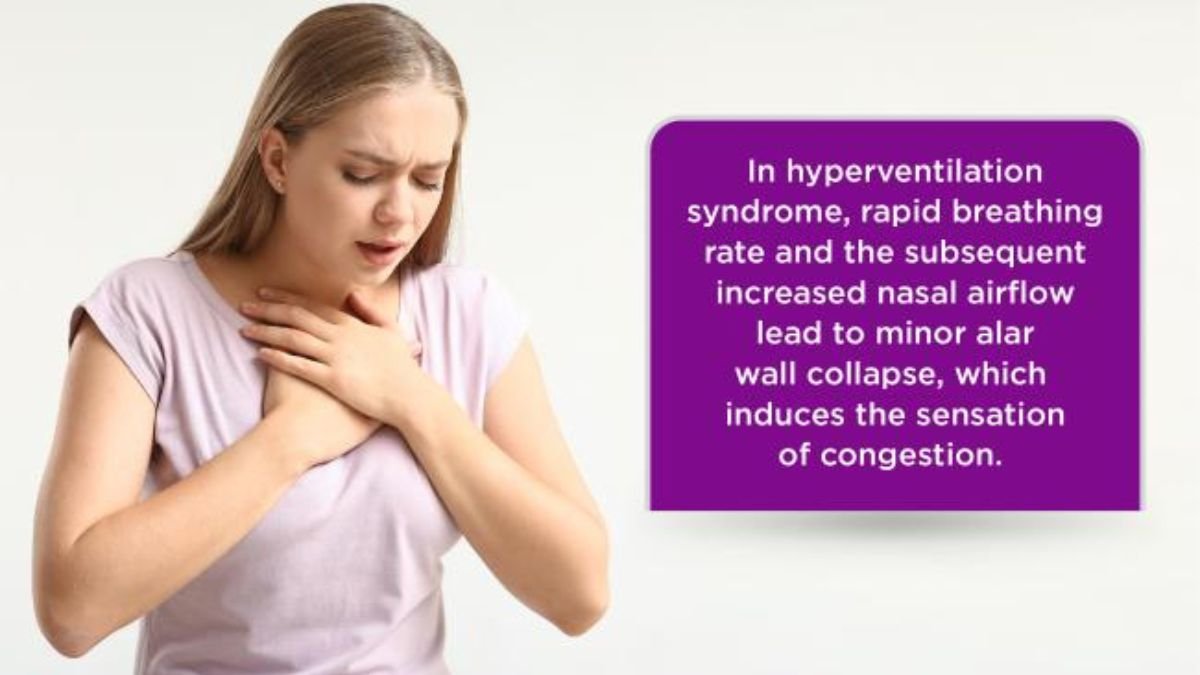Are you feeling anxious? Short of breath? Maybe even a little lightheaded? If so, you might be experiencing hyperventilation syndrome. Don’t worry, though – understanding this condition is the first step towards finding relief and regaining control. In this blog post, we’ll dive into everything you need to know about hyperventilation syndrome: what it is, common causes, symptoms to look out for, how it’s diagnosed, and most importantly – treatment options that can help bring you back to a state of calm. So take a deep breath (but not too deep!) and let’s explore the world of hyperventilation syndrome together!
Table of Contents
What is Hyperventilation Syndrome?
Hyperventilation syndrome is a condition characterized by rapid and shallow breathing, often caused by excessive anxiety or stress. When we’re in a state of panic or high emotional arousal, our body goes into overdrive and starts taking in more oxygen than it actually needs. This disrupts the balance of carbon dioxide in our bloodstream and can lead to a range of uncomfortable symptoms.
During hyperventilation, the levels of carbon dioxide decrease, which affects blood pH levels and can cause dizziness, tingling sensations, chest tightness, and even fainting. It’s important to note that hyperventilation syndrome is not the same as having difficulty breathing due to an underlying medical condition such as asthma or chronic obstructive pulmonary disease (COPD). Instead, it’s a response triggered by emotional factors rather than physical ones. Understanding this distinction is crucial for finding effective ways to manage the symptoms and regain control over your breath.
Common Causes of Hyperventilation Syndrome
Hyperventilation Syndrome can occur for a variety of reasons. One common cause is anxiety or panic attacks. When someone feels overwhelmed or stressed, their body’s natural response may be to breathe rapidly and shallowly, leading to hyperventilation. Another cause can be physical exertion or strenuous exercise. During intense workouts, the body demands more oxygen, causing rapid breathing that can trigger hyperventilation.
In addition, certain medical conditions such as asthma, chronic obstructive pulmonary disease (COPD), and heart disease can also contribute to hyperventilation syndrome. These underlying health issues affect respiratory function and may lead to irregular breathing patterns that result in excessive inhalation and exhalation.
Understanding the potential causes of hyperventilation syndrome is crucial in managing this condition effectively. By identifying the factors triggering hyperventilation episodes, individuals can take steps towards preventing future occurrences and seeking appropriate treatment options based on their specific circumstances.
Symptoms of Hyperventilation Syndrome
Hyperventilation Syndrome can manifest in a wide range of symptoms, making it important to recognize the signs and seek appropriate treatment. One common symptom is rapid breathing or feeling like you can’t catch your breath, even when at rest. This can lead to dizziness, lightheadedness, and a tingling sensation in the extremities.
Other symptoms may include chest tightness or pain, heart palpitations, and a sense of impending doom. Some individuals may also experience muscle tension and spasms, as well as headaches or migraines. These symptoms can be frightening and overwhelming but understanding their connection to hyperventilation syndrome is key to finding relief.
If you’re experiencing these symptoms on a regular basis or they become severe enough to interfere with your daily life, it’s important to consult with a healthcare professional for an accurate diagnosis and appropriate treatment options. Remember that seeking help early on can lead to effective management of hyperventilation syndrome and improve your overall quality of life.
Diagnosing Hyperventilation Syndrome
Diagnosing Hyperventilation Syndrome can be a challenging task, as its symptoms overlap with various other medical conditions. However, healthcare professionals have certain methods to help identify this syndrome.
They will conduct a thorough physical examination and review the patient’s medical history. They may also ask about any recent stressful events or anxiety triggers. Additionally, doctors may perform blood tests to rule out other possible causes of the symptoms.
Furthermore, they might use specialized breathing tests to measure carbon dioxide levels in the bloodstream and assess how efficiently oxygen is being delivered throughout the body. These diagnostic tools aid in determining if hyperventilation syndrome is indeed present and guide healthcare providers in developing an appropriate treatment plan tailored to each individual’s needs.
Treatment Options for Hyperventilation Syndrome
One of the key approaches to managing hyperventilation syndrome is through breathing techniques and relaxation exercises. These can help regulate your breathing and reduce the frequency and intensity of symptoms. Deep diaphragmatic breathing, also known as belly breathing, can be especially effective in calming your body down.
In addition to these techniques, medications may be prescribed by a healthcare professional to help alleviate symptoms. Medications such as sedatives or anti-anxiety drugs may be used on a short-term basis to provide relief during acute episodes. However, it’s important to note that medication should not be relied upon as a long-term solution.
Cognitive-Behavioral Therapy (CBT) is another treatment option that has shown promise in managing hyperventilation syndrome. This therapy focuses on identifying triggers and learning coping strategies to manage stress and anxiety effectively. By addressing the underlying psychological factors contributing to hyperventilation syndrome, CBT aims to break the cycle of excessive breathing patterns.
Remember that it’s essential to consult with a healthcare professional before starting any treatment plan for hyperventilation syndrome. They will guide you towards the most appropriate options based on your individual needs and circumstances.
Breathing Techniques and Relaxation Exercises
Breathing Techniques and Relaxation Exercises can be beneficial in managing Hyperventilation Syndrome. These techniques focus on regulating your breathing patterns, helping you to slow down and control your breaths. One effective technique is diaphragmatic breathing, where you consciously breathe deeply into your belly rather than shallowly into your chest. This helps to activate the body’s relaxation response and decrease feelings of anxiety or panic.
Another helpful technique is pursed lip breathing, which involves inhaling through the nose and exhaling slowly through pursed lips as if blowing out a candle. This encourages a longer exhalation, which can reduce hyperventilation symptoms such as dizziness or lightheadedness.
Practicing relaxation exercises like progressive muscle relaxation or guided imagery can also aid in reducing stress levels and promoting overall calmness. These exercises involve tensing and releasing different muscle groups or visualizing peaceful scenes to help relax both body and mind.
Remember, finding what works best for you may take some trial and error. It’s essential to practice these techniques regularly so that they become second nature when experiencing symptoms of Hyperventilation Syndrome. By incorporating these simple yet powerful strategies into your daily routine, you can regain control over your breathing patterns and manage hyper-ventilation more effectively.
Medications for Hyperventilation Syndrome
Medications for Hyper-ventilation Syndrome can be a helpful tool in managing symptoms and providing relief. There are several types of medications that may be prescribed, depending on the individual’s specific needs.
One common medication used is benzodiazepines, which help to reduce anxiety and promote relaxation. These medications work by slowing down the central nervous system, helping to calm excessive breathing patterns. Another option is selective serotonin reuptake inhibitors (SSRIs), which are commonly used to treat anxiety and depression. SSRIs can help regulate mood and reduce hyper-ventilation episodes.
It’s important to note that medication should always be used under the guidance of a healthcare professional, as they will assess your unique situation and determine what type of medication may be most effective for you. Additionally, it’s crucial to remember that medication alone is not a cure for Hyper-ventilation Syndrome but can be an effective part of a comprehensive treatment plan alongside other techniques such as breathing exercises and therapy.
Cognitive-Behavioral Therapy (CBT)
Cognitive-Behavioral Therapy (CBT) is a widely recognized and effective treatment option for individuals with Hyper-ventilation Syndrome. This therapy focuses on identifying and challenging negative thought patterns that contribute to hyper-ventilation episodes.
In CBT, therapists work closely with patients to help them develop coping strategies and relaxation techniques that can be used when symptoms arise. By addressing the underlying anxiety or stress that often accompanies hyper-ventilation, CBT aims to reduce the frequency and severity of episodes over time. Through guided discussions and practical exercises, individuals learn how to reframe their thoughts and behaviors in order to regain control over their breathing.
CBT has shown promising results in helping people manage Hyper-ventilation Syndrome by targeting both the physical symptoms and emotional factors involved. It empowers individuals with tools they can utilize outside of therapy sessions, promoting long-term symptom relief and improved quality of life.
Preventing Hyperventilation Syndrome
Preventing Hyper-ventilation Syndrome is crucial for those who have experienced it before or are at risk. One of the most effective ways to prevent hyper-ventilation is through proper breathing techniques and relaxation exercises. By practicing deep, diaphragmatic breathing and focusing on slow exhalation, you can regulate your breath and avoid hyper-ventilating.
Another important aspect of prevention is identifying triggers that may lead to hyper-ventilation episodes. These triggers can vary from person to person but may include stress, anxiety, certain medications, or even environmental factors such as strong odors or extreme temperatures. By recognizing these triggers and finding ways to manage them effectively, you can significantly reduce the likelihood of experiencing a hyper-ventilation episode.





